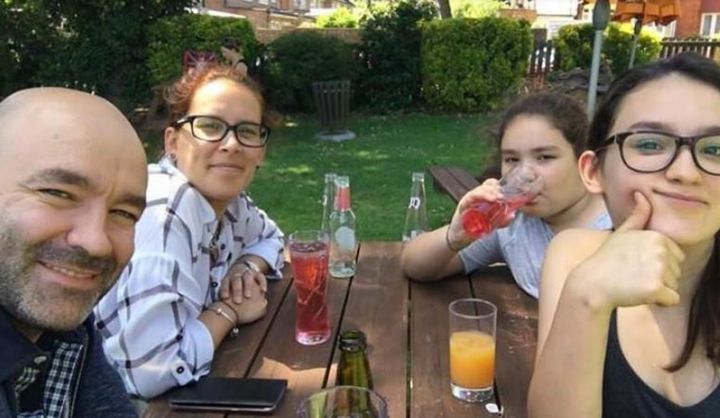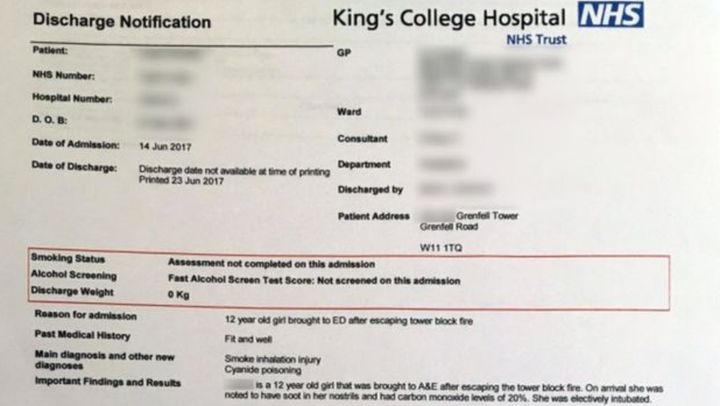
A 12-year-old survivor of the Grenfell Tower fire was diagnosed with cyanide poisoning, which may have been released by burning insulation or plastics during the June 14 tragedy.
Medical discharge records from Kings College Hospital show that Luana Gomes was treated for the effects of the highly toxic gas along with “smoke inhalation injury”. It also records that she received two doses of hydroxycobalamine “for cyanide poisoning”.
Gomes’ sister and mother, who was seven months pregnant at the time of the fire and lost her unborn baby, were also treated for risk of cyanide poisoning, her family told BBC Newsnight.
Fears that some of the at least 80 victims of the fire could have suffered cyanide poisoning began appearing in media reports a little over a week after the blaze.
While previous reports have suggested that three Grenfell survivors were treated with an antidote for cyanide poisoning, Gomes’ records are the first confirmation that a resident of the tower was diagnosed with it.
Andreia Gomes and her daughters were placed in medically induced comas when they were admitted to Kings College Hospital on the morning of the blaze.
Luana was unconscious for six days, her sister Megan for a week and their mother, four days. All three were treated with a cyanide antidote, but only Luana was diagnosed as having been poisoned.
King’s College Hospital confirmed to HuffPost UK late last month that they did administer the hydrogen cyanide antidote Cyanokit to victims of the blaze “as a precaution”, but did not detail how many residents had been given it.
The hospital is yet to comment on the Gomes case today, or reply to a request from HuffPost UK to detail how many victims of the tragedy it has treated for cyanide poisoning.
Signs and symptoms of cyanide poisoning include headaches, vomiting, chest pains, loss of consciousness, seizures, cardiac arrest. It can also cause death within seconds. Cyanide poisoning stops cells from being able to produce energy from oxygen.
Andreia Gomes told the BBC that she blames authorities - whose failures to protect Grenfell residents are now subject to a public inquiry - for “killing my son”.

Her husband, Marcio Gomes, has told how he decided to make a run for safety with his family around 4am, several hours after the fire took hold, and as flames raged in his bedroom on the 21st floor. The family stepped over bodies as they fled, gasping for breath with every step.
“What I didn’t account for was the amount of bodies we had to trip over or step on. We were stepping on people’s arms or legs,” he said.
Marcio Gomes was the only member of the family to remain conscious.
Most cases of cyanide poisoning are diagnosed in victims of residential fires, but it is not known what produced cyanide in the Grenfell blaze, though much has been made of the cladding used during a refurbishment that is believed to have helped spread the fire. A cheaper option of cladding was fitted that was less fire retardant and contained plastic between layers of aluminium.
The cladding, HuffPost UK reported earlier this month, could have produced enough deadly hydrogen cyanide to fill every flat.
Richard Hull, professor of chemistry and fire science at the University of Central Lancashire, told Sky News at the time: “The outside wall of the building had 150mm of PIR foam (fitted), and once the fire had spread to that every flat would have its own source of PIR foam, which would have produced enough hydrogen cyanide to kill all the people in that flat.”
Manufacturer Celotex stated that the insulation would have released “toxic gases” if it caught fire.
A fire safety expert and former civil servant told HuffPost UK that sofas and mattresses in Grenfell may also have released cyanide during the fire.
Terry Edge, who led an official review into fire safety in 2014, said that, when flame retardant chemicals used on sofas and mattresses are burned, they produce hydrogen cyanide very quickly.
He said: “Those poor people were caught by toxic fumes from both inside and outside the building.”
Richard Hull, Professor of chemistry and fire science at the University of Central Lancashire, explained to the BBC that plastic foam insulation is “effectively made from crude oil” so combusts in the same was as other petrochemicals.
“It’s got a lot of nitrogen in it and therefore when it burns it produces both carbon monoxide and hydrogen cyanide,” he said.
A spokesman for the British Rigid Urethane Foam Manufacturer’s Association (BRUFMA) - the trade body which represents makers of insulation of the kind used at Grenfell Tower - told the BBC that no assumptions should be made about what materials created toxic gases in the fire.
As of Thursday morning, more than £36,000 had been raised on a Gofundme page set-up for the Gomes family.
Neil Payne, who launched the fundraiser, wrote on the page: “Our friends Andreia and Marcio have suffered a devastating event, with their home being destroyed by fire.
“Luckily our hero Marcio managed to get them all out although they are in hospital but stable. They have lost everything and I am setting this up so that we can all help in a small way to rebuild their lives.”
